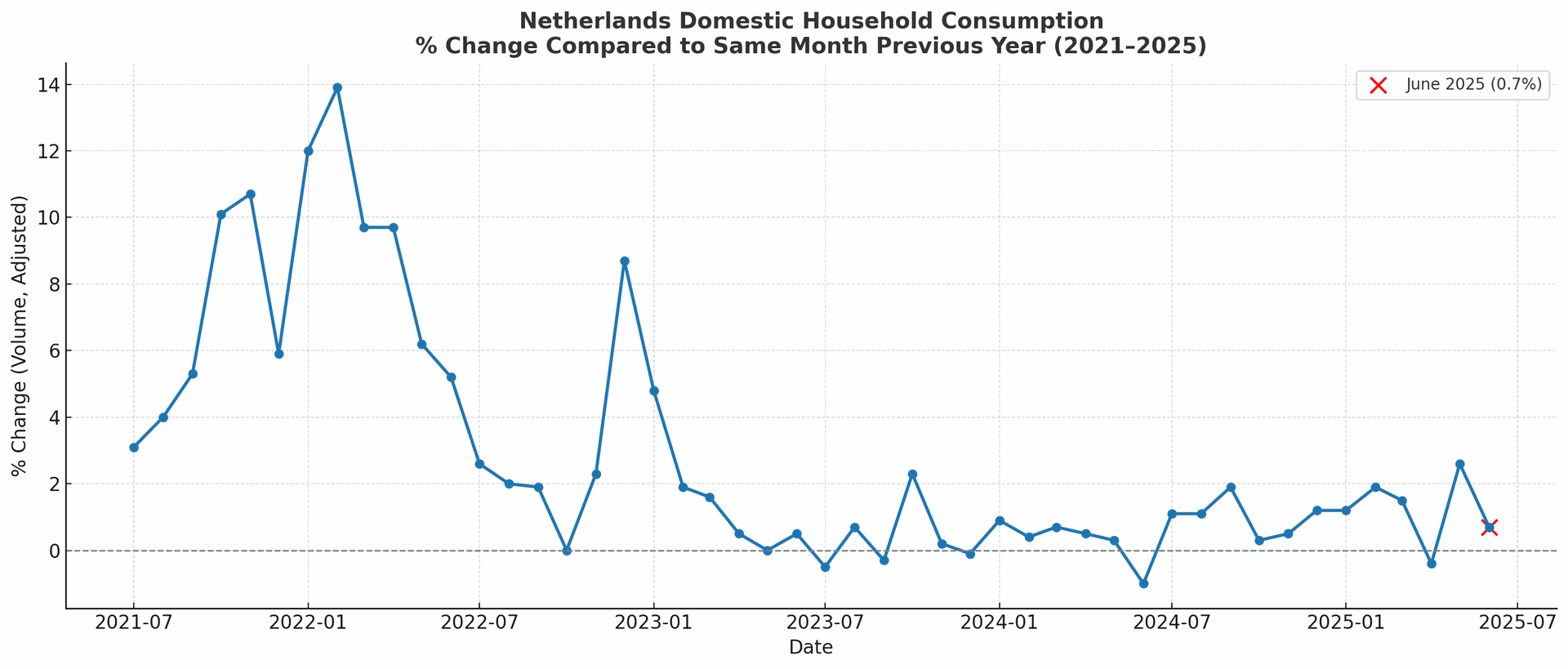Numbers are often treated like weather forecasts, glanced at, maybe discussed, then forgotten. But behind each percentage point, there is a story about how we live, choose, adapt, and sometimes contradict ourselves.
In June 2025, Dutch households purchased 0.7% more goods and services than in June 2024. On paper, it’s growth. In reality, it’s a fragile heartbeat, the kind that makes economists squint and entrepreneurs raise an eyebrow.
A Glass Half Full… of Shoes and Coffee
The growth wasn’t spread evenly. Goods led the dance, services lagged behind.
- Durable goods: up 3.7%: a wave of shoes, clothing, and electrical appliances. Curiously, fewer passenger cars rolled out of the dealerships.
- Food, beverages, and tobacco: up 2.3%: the essentials and small indulgences that quietly define our habits.
- Other goods: down 1%, mostly due to lower spending on energy and motor fuels.
- Services: down 0.4%, thanks to a dip in hospitality spending, even if recreation and transport saw an uptick.
In other words, we’re buying more things but holding back on experiences. A telling behavioral signal.
Why the Numbers Whisper, Not Shout
Consumption data is adjusted for both price changes and shopping-day patterns. That means the 0.7% is pure volume — no inflation fog, no calendar distortions. It’s the real movement of goods and services, stripped of excuses.
Yet, the CBS Consumption Radar tells us that July felt just as unfavorable as June. The indicators, consumer expectations, labor market conditions, and wealth trends, didn’t shift enough to lift the mood. People felt slightly better about their personal finances, but stock markets slipped, muting optimism.
From Pandemic Surges to a Cautious Stroll
Look at the bigger arc:
- Early 2022 had double-digit jumps, fueled by post-lockdown release.
- 2023 saw consumption growth flatten and dip.
- 2024 was a cautious plateau, occasionally dipping into the red.
- 2025 has started with mild gains, punctuated by April’s -0.4% drop and May’s sharper +2.6%.
This is not a sprint. It’s a stop-start walk through a marketplace where every purchase is weighed against uncertainty.

What Entrepreneurs Should Read Between the Lines
The micro shift from services to goods is not random. It often signals:
- Practical prioritization: people buying what they can “hold” and postpone what they can “experience”.
- Quiet caution: an undercurrent of financial restraint, even when jobs and incomes seem stable.
- Segment reshuffling: hospitality, travel, and cultural events may need sharper value propositions, while retail for durable goods could exploit short-term optimism.
For business owners, the 0.7% is not a reason to celebrate: it’s a reminder to tune in to behavioral currents, not just macro tides.
The Soul of the 0.7%
Think of this as a diagnostic, not a verdict. A society that buys more shoes but skips dinner out is making a subtle statement about security, comfort, and perceived risk. And if you’re running a business, that’s the conversation you need to hear: the one between the lines of the CBS report, where the why is more valuable than the what.
Because in the end, the health of an economy is not measured only by what people buy, but by what they hesitate to buy.
Co-Creator of Xtroverso | Head of Global GRC @ ZENTRIQ™
Paolo Maria Pavan builds systems that balance rules with freedom, clarity with transformation. In his third life, he writes and speaks openly about markets, governance, and risk, not as a trader chasing price, but as a reader of patterns, behaviors, and distortions. A serial entrepreneur shaped by failure and reinvention, he sees governance as a living force for trust and progress, and refuses to avoid the hard conversations that make it real.

